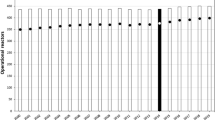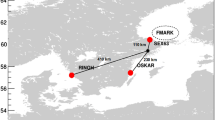Abstract
Activity concentration data from ambient radioxenon measurements in ground level air, which were carried out in Europe in the framework of the International Noble Gas Experiment (INGE) in support of the development and build-up of a radioxenon monitoring network for the Comprehensive Nuclear-Test-Ban Treaty verification regime are presented and discussed. Six measurement stations provided data from 5 years of measurements performed between 2003 and 2008: Longyearbyen (Spitsbergen, Norway), Stockholm (Sweden), Dubna (Russian Federation), Schauinsland Mountain (Germany), Bruyères-le-Châtel and Marseille (both France). The noble gas systems used within the INGE are designed to continuously measure low concentrations of the four radioxenon isotopes which are most relevant for detection of nuclear explosions: 131mXe, 133mXe, 133Xe and 135Xe with a time resolution less than or equal to 24 h and a minimum detectable concentration of 133Xe less than 1 mBq/m3. This European cluster of six stations is particularly interesting because it is highly influenced by a high density of nuclear power reactors and some radiopharmaceutical production facilities. The activity concentrations at the European INGE stations are studied to characterise the influence of civilian releases, to be able to distinguish them from possible nuclear explosions. It was found that the mean activity concentration of the most frequently detected isotope, 133Xe, was 5–20 mBq/m3 within Central Europe where most nuclear installations are situated (Bruyères-le-Châtel and Schauinsland), 1.4–2.4 mBq/m3 just outside that region (Stockholm, Dubna and Marseille) and 0.2 mBq/m3 in the remote polar station of Spitsbergen. No seasonal trends could be observed from the data. Two interesting events have been examined and their source regions have been identified using atmospheric backtracking methods that deploy Lagrangian particle dispersion modelling and inversion techniques. The results are consistent with known releases of a radiopharmaceutical facility.










Similar content being viewed by others
Notes
For a long time only Germany was known to have measured radioxenon from the Chernobyl accident. Recently, however, 133Xe concentrations around 1.5 Bq/m3 were reported from late April 1986 in Cherepovetz, Russia (Pakhomov and Dubasov, 2008).
References
Aatami (2003), User Manual of Radionuclide Analysis and Evaluation Software Aatami, Version 3.15. Preparatory Commission of the Comprehensive Nuclear Test Ban Treaty Organisation, Vienna, Austria.
Achim, P., Bellivier, A., Armand, P., Taffary, T., Fontaine, J.P., and Piwowarczyk, J., C. (2007), Contributions of xenon releases in the atmosphere from radionuclide production facilities and nuclear nuclear power plants to the detection of 133 Xe by SPALAX systems in werstern Europe, Proc. 11th Internat. Conf. Harmonisation within Atmospheric Dispersion Modelling for Regulatory Purposes.
Auer, M., Kumberg, T., Sartorius, H., Wernsperger, B., and Schlosser, C. (2010), Ten years of development of equipment for measurement of atmospheric radioactive xenon for the verification of the CTBT, Pure Appl. Geophys. 167, 4–5.
Auer, M., Axelsson, A., Blanchard, X., Bowyer, T.W., Brachet, G., Bulowski, I., Dubasov, Y., Elmgren, K., Fontaine, J.P., Harms, W., Hayes, J.C., Heimbigner, T.R., McIntyre, J.I., Panisko, M.E., Popov, Y., Ringbom, A., Sartorius, H., Schmid, S., Schulze, J., Schlosser, C., Taffary, T., Weiss, W., and Wernsperger, B. (2004), Intercomparison experiments of systems for the measurement of xenon radionuclides in the atmosphere, Appl. Radiation and Isotopes 60, 6, 863–877.
Axelsson, A. (2007), Development, Demonstration, Testing and Evaluation of On-Site Inspection Equipment for Xenon Sampling, Separation and Measurement. CTBTO Technical Report, CTBT/PTS/TR/2007-1, CTBTO, Vienna.
Becker, A. (2006), A new tool for NDC analysis of atmospheric transport calculations, CTBTO Spectrum 7, 19–24.
Becker, A., Wotawa, G., De Geer, L.-E., Seibert, P., Draxler, R.R., Sloan, C., D’Amours, R., Hort, M., Glaab, H., Heinrich, P., Grillon, Y., Shershakov, V., Katayama, K., Zhang, Y., Stewart, P., Hirtl, M., Jean, M., and Chen, P. (2007), Global backtracking of anthropogenic radionuclides by means of a receptor oriented ensemble dispersion modelling system in support of Nuclear-Test-Ban Treaty verification, Atmos. Environ. 41, 21, 4520–4534.
Bernström, B. and De Geer, L.-E. (1983), Mätning av Små Mängder Xenon-133 I Luft, FOA-rapport ISSN 0347-3694, C 20515-A1, FOA, Stockholm, Sweden.
Bieringer, J. and Schlosser, C. (2004), Monitoring ground-level air for trace analysis: Methods and results, Analyt. Bioanalyt. Chem. 379, 2, 234–241.
BMU (2007), Umweltradioaktivität und Strahlenbelastung—Jahresbericht 2006 (in German), Reaktorsicherheit, Bundesministerium für Umwelt, Naturschutz und Reaktorsicherheit, pp. 100–104.
Bowyer, T.W., Schlosser, C., Abel, K.H., Auer, M., Hayes, J.C., Heimbigner, T.R., McIntyre, J.I., Panisko, M.E., Reeder, P.L., Satorius, H., Schulze, J., and Weiss, W. (2002), Detection and analysis of xenon isotopes for the comprehensive nuclear-test-ban treaty international monitoring system, J. Environ. Radioact. 59, 2, 139–151.
D’Agostino, R.B. and Stephens, M.A. (1986), Goodness-of-Fit Techniques, (Marcel Dekker) 0824774876.
Dahlman, O., Mykkeltveit, S., and Haak H. (2009), Nuclear Test Ban: Converting Political Visions to Reality (Springer, 1st edition, 2009), ISBN-13: 978–1402068836.
De Geer, L.-E. (1996), Atmospheric radionuclide monitoring: A Swedish perspective. In Huseby, E.S. and Dainty, A.M., eds., Monitoring a Comprehensive Nuclear Test Ban Treaty (pp. 157–177) (The Netherlands: Kluwer Academic Publishers, 1996).
Dubasov, Y.V., Popov, Y.S., Prelovskii, V.V., Donets, A.Y., Kazarinov, N.M., V. V. Mishurinskii, Popov, V.Y., Rykov, Y.M., and Skirda, N.V. (2005), The APИКC-01 Automatic facility for measuring concentrations of radioactive xenon isotopes in the atmosphere, Instrum. Experim. Techn. 48, 3, 373–379.
Ehhalt, D., Muennich, K.O., Roether, W., Schoelch, J., and Stich, W. (1963), Artificially produced radioactive noble gases in the atmosphere, J. Geophys. Res. 68, 13, 3817–3821.
Fontaine, J.P., Pointurier, F., Blanchard, X., and Taffary, T. (2004), Atmospheric xenon radioactive isotope monitoring, J. Environ. Radioact. 72, 1–2, 129–135.
Igarashi, Y., Miyao, T., Aoyama, M., Hirose, K., Sartorius, H., and Weiss, W. (2000a), Radioactive noble gases in surface air monitored at MRI, Tsukuba, before and after the JCO accident, J. Environ. Radioact. 50, 1–2, 107–118.
Igarashi, Y., Sartorius, H., Miyao, T., Weiss, W., Fushimi, K., Aoyama, M., Hirose, K., and Inoue, H.Y. (2000b), 85 Kr and 133 Xe monitoring at MRI, Tsukuba and its importance, J. Environ. Radioact. 48, 2, 191–202.
Kalinowski, M.B. and Pistner, C. (2006), Isotopic signature of atmospheric xenon released from light water reactors, J. Environ. Radioact. 88, 3, 215–235.
Kalinowski, M.B. and Tuma, M.P. (2009), Global radioxenon emission inventory based on nuclear power reactor reports, J. Environ. Radioact. 100, 58–70.
Kalinowski, M.B., Axelsson, A., Bean, M., Blanchard, X., Bowyer, T.W., Brachet, G., McIntyre, J.I., Peters, J., Pistner, C., Raith, M., Ringbom, A., Saey, P.R.J., Schlosser, C., Stocki, T.J., Taffary, T., and Ungar, R.K. (2010), Discrimination of nuclear explosions against civilian sources based on atmospheric xenon isotopic activity ratios, Pure Appl. Geophys. 167, 4–5.
Kocher, D.C. (1980), Dose-rate conversion factors for external exposure to photon and electron radiation from radionuclides occurring in routine releases from nuclear fuel cycle facilities, Health Phys. 38, 543.
Le Petit, G., Armand, P., Brachet, G., Taffary, T., Fontaine, J., P., Achim, P., Blanchard, X., Piwowarczyk, J. C., and Pointurier, F. (2008), Contribution to the development of atmospheric radioxenon monitoring, J. Radioanalyt. Nuclear Chem. 276, 2, 391–398.
Mikhailov, V., Dubasov, Y.V., and Matushenko, A.M. (1999), Nuclear Explosions in the USSR, The North Test Site, Reference Material on nuclear explosions, radiology, radiation safety (ver. 2). Tests, Interagency Expert Commission on Assessment of Radiation and Seismic Safety of Underground Nuclear, V.G. Khlopin Radium Institute, Russian Nuclear Society, St. Petersburg, Russian Federation.
Pakhomov, S.A. and Dubasov, Y.V. (2008). Estimation of explosion energy yield at Chernobyl NPP accident, Geophys. Res. Abstr. 10, A-09280.
Ringbom, A., Larson, T., Axelsson, A., Elmgren, K., and Johansson, C. (2003), SAUNA–a system for automatic sampling, processing, and analysis of radioactive xenon, Nuclear Instruments and Methods in Physics Research Section A: Accelerators, Spectrometers, Detectors and Associated Equipment, 508, 3, 542–553.
Saey, P.R.J. (2007), Ultra-low-level measurements of argon, krypton and radioxenon for treaty verification purposes, ESARDA Bull. 36, July 2007, 42–55.
Saey, P.R.J. (2009), The influence of radiopharmaceutical isotope production on the global radioxenon background, J. Environ. Radioact. 100, 5, 396–406.
Saey, P.R.J. and De Geer, L.-E. (2005), Notes on radioxenon measurements for CTBT verification purposes, Appl. Radiation Isotopes 63, 5–6, 765–773.
Saey, P.R.J., Wotawa, G., De Geer, L.-E., Axelsson, A., Bean, M., d’Amours, R., Elmgren, K., Peterson, J., Ringbom, A., Stocki, T.J., and Ungar, R.K. (2006), Radioxenon background at high northern latitudes, J. Geophys. Res. 111, D17306.
Schlosser, C., Sartorius, H., and Schmid, S. (2003), Status of the SPALAX at the RN-33 station, International Workshop on Atmospheric Radioxenon Measurements, Ottawa, Canada, 29 September–2 October, 2003.
Schölch, J., Stich, W., and Münnich, K.O. (1966), Measurements of radioactive xenon in the atmosphere, Tellus XVIII, 2, 298–300.
Stockburger, H., Sartorius, H., and Sittkus, A. (1977), Messung der Krypton-85- und Xenon-133-Aktivität der atmosphärischen Luft., Z. Naturforsch. 32a, 1249–1253.
UNGA (1996), United Nations General Assembly Resolution Number 50/245. In U.N. New York, U.S.A.
Ungar, K., Hoffman, I., Yi, J., Stocki, T., De Geer, L.-E., Walters, M., and Becker, A. (2007), Use of existing IDC routine numerical calculations as a prototype standard radionuclide numerical ATM product for operational categorization and categorization development. In International Noble Gas Experiment, Workshop, Las Vegas, NV, U.S.A.
UNSCEAR (2000), Sources and Effects of Ionizing Radiation, Report to the General Assembly by the United Nations Scientific Committee on the Effects of Atomic Radiation. 1, Nations, United, UNSCEAR, New York.
Van der Stricht, S., and Janssens, A. (2005), Radioactive effluents from nuclear power stations and nuclear fuel reprocessing plants in the European Union, 1999–2003. Radiation Protection 143, Directorate-General Environment.
Weiss, W. and Leeb, H. (1993), IMIS—The German integrated radioactivity information and decision support system, Radiat. Prot. Dosimetry 50, 2–4, 163–170.
Wotawa, G., De Geer, L.-E., Denier, P., Kalinowski, M., Toivonen, H., D’Amours, R., Desiato, F., Issartel, J.-P., Langer, M., Seibert, P., Frank, A., Sloan, C., and Yamazawa, H. (2003), Atmospheric transport modelling in support of CTBT verification—Overview and basic concepts, Atmos. Environ., 37, 18, 2529–2537.
Ziegler, C.A. and Jacobson, D. (1995), Spying Without Spies: Origins of America’s Secret Nuclear Surveillance System, Westport, CT, USA (Praeger Publishers 1995), ISBN-13: 978-0275950491.
Acknowledgments
The presented data would not be available without the conscientiousness of the local station operators, the crew from CEA in Bruyères-le-Châtel, from KRI in Dubna, from SFI in Marseille, from the BfS on the Schauinsland Mountain, from SvalSat in Spitsbergen and from FOI and Gammadata in Stockholm. We are grateful to Dr. Kurt Ungar (Health Canada) for giving permission to use the data acquired by their equipment in Marseille. We would also like to thank all colleagues within the INGE collaboration for fruitful work and discussions. The authors are also grateful to Dr. Gerald Kirchner (BfS, Germany) for his critical review and valuable comments on the manuscript.
Author information
Authors and Affiliations
Corresponding author
Additional information
The views expressed in this publication are those of the authors and do not necessarily reflect the views of the CTBTO Preparatory Commission or any of the participating institutions.
Rights and permissions
About this article
Cite this article
Saey, P.R.J., Schlosser, C., Achim, P. et al. Environmental Radioxenon Levels in Europe: a Comprehensive Overview. Pure Appl. Geophys. 167, 499–515 (2010). https://doi.org/10.1007/s00024-009-0034-z
Received:
Revised:
Accepted:
Published:
Issue Date:
DOI: https://doi.org/10.1007/s00024-009-0034-z




